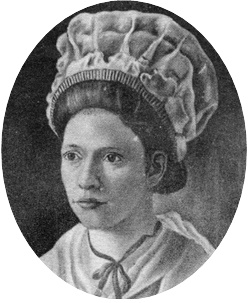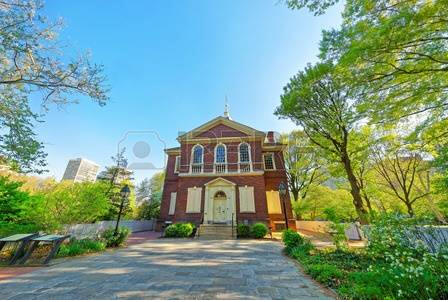Lydia Barrington Darragh (1729 - 1789) Irish-born American patriot, Washington's Revolutionary War spy.  Lydia Barrington Darragh, the youngest child of six children, was born to John Barrington, a weaver by trade, and Mary Aldridge Barrington in Dublin, Ireland in 1729. The Barrington’s were members of the Religious Society of Friends, nicknamed Quakers, whose English ancestors resettled in Ireland in the 16th century Lydia Barrington Darragh, the youngest child of six children, was born to John Barrington, a weaver by trade, and Mary Aldridge Barrington in Dublin, Ireland in 1729. The Barrington’s were members of the Religious Society of Friends, nicknamed Quakers, whose English ancestors resettled in Ireland in the 16th century
The Religious Society of Friends was founded by George Fox in England in 1652(1). Simply stated Quakerism embraced pacifism as a core principle, rejected the trimmings of organized religion, promoted social reform, and emphasized caring for the less fortunate within and without their own communities as an unselfish expression of their faith. The first recorded Quaker meeting held in Ireland was in 1654 at the home of William Edmundson in Lurgan, Co. Armagh. Edmundson, the acknowledge founder of Quakerism in Ireland was born in England. He resettled in Ireland after the Cromwellian defeat of the Irish Confederate Armies in 1653. Lydia’s education was informal in nature, meaning that it was acquired outside a standard school setting. The fact that she was brought up in a supportive Quaker setting afforded her the opportunity to avail of educational resources resident within the community including access to literacy tutors. She also had access to the advice and support of skilled tradesmen and women who helped her acquire her the necessary skills that would, later in life, help care for her family and contribute to the welfare of her close-knit community. In 1753 Lydia married John Darragh, a fellow Quaker and literacy tutor. The wedding took place at the Friends Meeting House in Sycamore Lane in Dublin located in what is now known as the Temple Bar area. Within a few years of their marriage, they emigrated to the American Colonies. They settled in Philadelphia, one of the preferred destinations for many of the early colonists, because of its adherence to Quaker principles and its tolerance of diverse religious beliefs and cultures. After settling into their new life in the colonies, John resumed his tutoring career and Lydia worked as a midwife. For the next twenty years they lived their lives in adherence with Quaker beliefs; contributing to the common good and raising a family of five children. Four other children did not survive infancy. In October of 1775, some six months after the onset of the Revolutionary War their oldest son, Charles, broke with Quaker orthodoxy by enlisting in the 2nd Pennsylvania Regiment. Despite the family’s strong belief in pacifism, they were, nonetheless, surreptitiously predisposed to the patriot’s cause. As with many of their fellow Irish immigrants of the same or of different religious affiliations, they were not inclined to stand aloof to let the same Imperial monarchy at whose hands they had suffered persecution and deprivation in the Old World impose the same draconian rule in the New World where they now made their home. When the British Army, under the command of General Howe, arrived in Philadelphia on September 26, 1777, having defeated General George Washington’s Army at Brandywine Creek, enroute, from New York. Before Howes arrival approximately one third of the population had left, amongst them the Darragh’s youngest children who stayed with relatives in the suburbs. Those who remained were mostly Loyalists and Quakers who would not pose a problem to the British presence because of their loyalty to the crown of their Christian pacifist beliefs. After an October attempt to retake in city failed, Washington army retreated to Whitemarsh located fifteen, miles, or so, northwest of the Philadelphia City center. After taking possession of the city, Howe set-up his headquarters across the street from Lydia’s residence, the Loxley house at 177 South 2nd St. not far from the Delaware River. The Loxley house was a spacious two-story house that Howe ordered vacated so that he could house his staff there. After an officer on Howe’s staff, who happened to be a cousin of Lydia, interceded on her behalf, she was allowed to stay but, would have to vacate the downstairs whenever Howe wanted it for staff meetings. The fact that she was related to one of his officers, and a Quaker, put her above suspicion of being anything other than a loyal subject, someone that could be trusted. Howe was wrong in his assessment of Lydia. Whenever Howe held his meeting in Lydia’s parlor the family retired to the upstairs bedrooms. With a little subterfuge and daring Lydia was able to eavesdrop on the proceedings below without being exposed. What she heard was disturbing and for the first time in her life her Quaker beliefs of not engaging in or taking sided in conflict were at odds with her sense of patriotism. Patriotism prevailed compelling her to pass on what she heard to Washington. How she accomplished this is not clear as there are varying versions of the methods she employed. As was the common practice, people leaving or reentering the areas controlled by either Howe or Washington needed passes to cross picket lines. The ‘no-mans-land’ in-between was where information regarding the disposition and movements of the opposing armies was passed back and forth by enemy agents and partisan sympathizers. Some accounts have it that Lydia would send one of her sons into the ‘no-mans-land’ on some plausible pretext and once there pass on what she heard Howe discuss to her son, Charles, a soldier in Washington’s army. At one of Howe’s meetings on December 2nd, she overheard Howe and his officers discuss plans for a surprise attack on Washington’s Army at Whitemarsh early on the morning of December 5th. As the meeting was breaking up, she quietly returned to her room. When one of the officers knocked on her bedroom door, she opened it after an adequate delay that gave the impression she was awakened. He left satisfied she heard nothing. The next morning, she, instead of her son, lined up to get permission from a British officer or agent to cross the British picket line to purchase flour at a gristmill located approximately six miles north of the city center in Frankfort. As this was a common occurrence by many of the city’s residence it did not raise suspicion. With a pass in hand, she set out on her audacious journey on December 4, crossing British picket lines without incident. After arriving at the mill, she filled her sack with flour and headed for the nearby Rising Sun Tavern, a known hangout for patriot agents. Along the way she met Colonel Thomas Craig, one of Washington’s officers, whom she knew, and informed him of General Howes planned attack on Washington’s army early the next morning. She also passed along detailed information on the number of troops, cannon, and other armaments that Howes would have at his disposal. She then returned to her home. In the meantime, Colonel Craig passed on Lydia’s information to Colonel Elias Boudinot, Commissary General of Prisoners who was staying at the Rising Sun Tavern. He, in turn, passed it on to General Washington who immediately acted on the information. On the morning of December 5, the approaching British army was observed, some miles away, at Chestnut Hill. Washington sent forward six hundred troops of the Pennsylvania militia to blunt its advance. Howe immediately realized that Washington knew of his plans and he, Washington, had strategically positioned his troops and was ready to take him on. As a consequence, the planned attack to destroy Washington’s army turned into a series of ferocious but indecisive skirmishes, culminating in a humiliating British withdrawal on December the 8th. Lydia observed the dejected British column return to its base, pleased in the knowledge that her efforts helped to save Washington’s army and, hopefully, not in the too distant future, herald the dawn of liberty and release from the yoke of tyranny. However, the British army’s senior staff set in motion an investigation to determine who informed General Washington of the impending attack despite the secrecy surrounding its planning and preparations. On the morning of December 9, spymaster Major John Andre knocked on Lydia’s door and questioned her extensively on who was in the house while the meeting was going on and what each one was doing. She was able to convince him that everyone had gone to bed early and were all asleep. His acceptance of her story was based on the fact that she was a woman who, in his misogynistic reasoning, was not capable of understanding anything significant, other than simple household related instructions. He also reasoned that even if she heard something she was incapable of acting on it. Even so, if she had broken down and confessed during the interrogation her punishment would have been a speedy and public execution. Although her spying career only lasted a matter of months, the enormity of that undertaking can best be understood in considering the consequences if she had stood aloof or acted otherwise. A surprise attack would have caught Washington unprepared resulting in the possible destruction of his army and his capture. Such an outcome would, probably, have brought the revolution to an end, or at best severely limit its chances of success. Lydia’s bravery averted that probability. When the French recognized the United States by the signing of the Treaty of Alliance in February of 1778 the Revolutionary War entered a new phase. Fearing a French blockade of the Chesapeake coupled and the need to protect New York, General Clinton, who had taken over from General Howe, set in motion plans to evacuate Philadelphia. On June 8, 1783, he headed north to New York after first transporting heavy armament and known loyalist to New York on board ships via the Chesapeake. After the British left, to the consternation of the loyalist left behind, American forces returned as did the residents who had left when the British took over including the Darragh’s youngest children. With the family intact again, life returned to normal. Lydia continued to support the Independence cause by caring for the displaced and injured victims of the war. After Lydia’s husband, John, died in 1783 she moved to a new home from where she operated a store until her own death on December 26, 1789. Her contribution to the war effort, an affront to Quakerism, was not acceptable to the Quakers who barred her from attending Friends meetings, a price she was willing to accept. The same sanction was meted out to her soldier son, Charles, who fought for America’s Independence. Nonetheless, she was buried in the Friends' Burial Ground at Fourth and Arch Streets in Philadelphia. Contributor: Tomás Ó Coısdealbha
Notes: 1) George Fox (1624-1691) was born in Leicestershire, England. As a young man he became disillusioned with the religious life of his time. He found many other “seekers” who also felt the churches had become bogged down with traditions, rituals, and power politics, and together they tried to lead a renewal of Christianity and live out the Christian message more simply. In due course they called themselves The Religious Society of Friends. Many suffered persecution and imprisonment for their beliefs. “Quaker” was a nick name which stuck, and now we are known as Friends or Quakers.
cemetery AND grave location NAME: Friends Arch Street Meeting House Burial Ground PHONE: (215) 413-1804 ADDRESS: 320 Arch St., Philadelphia PA.19106
BURIAL GROUND 
Friends Meeting House Burial Ground |